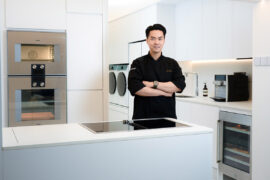Ashley Tucker speaks to Australian furniture designer Tom Skeehan about his design process, working with Australian manufacturers, and what it means to have a strong material narrative in your work.
Tom Skeehan discovered he had a talent for furniture design when he was just a kid, skills that were passed on from his father Vince Skeehan, who is a veteran cabinet maker and carpenter. Skeehan’s earliest memories are of his dad showing him how to draw cubes and make his own wooden toys. “I was very fortunate to be exposed to the world of furniture making from a really young age,” he says. These shared moments with his dad have informed Skeehan’s innate knowledge of design and connection to his tools and materials, which continue to be brought to the fore in his work.
The last few years have proven busy for the designer. Since he won Indesign’s Launchpad in 2012, Tom’s exposure in the industry has grown, along with opportunities that have seen his work exhibited on the world stage. “This year has been a real turning point for the studio,” says Skeehan, who set up his eponymous Canberra-based furniture studio in 2007, years before graduating from an industrial design degree at the University of Canberra. “I signed my newest collection HOSHI with Stylecraft in November last year and we have had an incredible response to the range. I was also invited by Local Milan to exhibit a new folding chair titled HUP HUP in Milan this April, and I have the opportunity to take the chair to New York later this year for a solo show.”
Skeehan’s latest project, the HUP HUP chair has been in development for three years, which according to Skeehan began as a “very indulgent” project that was developed in parallel to his more commercial projects. “The brief was to design a limited edition minimal timber folding chair that could be hung on the wall, while still reading as a traditional dining chair once assembled,” he explains. “Displaying the chair on the wall was one of the most important features of the product. I loved the idea that the chair now becomes an expression of beautiful timbers and could be enjoyed as an artwork.” Skeehan launched the chair as a limited edition piece; only 20 have been made thus far in his Canberra studio. However, the chair has been designed for production – each component lends itself to CNC manufacturing – and he has plans to formally release the product by the end of the year.
Since establishing his practice almost 10 years ago, Skeehan has become a part of a growing collective of Australian designers who are serious about the advancement of the design industry, advocating for and supporting Australian manufacturers at every opportunity. He continues to work closely with them to strengthen his creative vision. Having spent the last few years building close relationships with manufactures he respects and admires, Skeehan attributes his success largely to those moments working together. “[I] wouldn’t be where I am without their support and wiliness to collaborate,” he reflects. “These relations allow me to draw on their experience and understanding of a material that then helps guide the design process.” Equally they share his ethos and passion for sustainability, adding that they share his vision for the “sustainable selection and the efficient use of materials”, as well as simply creating products that will last.
Material exploration is at the very core of Skeehan’s design process. When asked what are the main influences are when conceiving a piece of work, he elucidates that materials are his manifestation of the final outcome. “I want to design furniture that has a purpose and a strong material narrative,” he shares. “Allowing the honest expression of material to be the driving aesthetic; paring back to a minimal form that often expresses the manufacturing process.”
However, when conceiving a new project it is the brief that comes first, and it continues to hold an important role throughout the life of Skeehan’s projects. “Understanding a material’s properties and letting them inform the final design is important, however the design brief will come first,” he explains. “It has taken a few years to be able to develop a considered brief; this reference document is the backbone of a product’s development and keeps the project in check.”
Tom’s other design influences stem from his experience absorbing Japanese design and architecture while travelling abroad, which can be seen in the work he produces. “From a pure design perspective I have always admired the work of designer Naoto Fukasawa and architect Tadao Ando. They have a very honest design approach and really consider the purpose of a project and the materials used. I have been lucky enough to travel through Japan early in my career and this really grounded my philosophy and has been something I have kept very close to the way I develop a brief and design. In Australia, I take a lot of inspiration from the manufactures I work with – they are the core of my business and I’m lucky to work alongside them. The relationship with them is ever growing and their feedback and support are very inspiring.”
Citing his making background as a benefit to the initial stages of design, Skeehan says getting hands on allows him to be fully engaged in the prototyping stage, a part that happens to be his favourite. “This is where the idea is often at its biggest and you are constantly resolving details and experimenting with materials – always measuring it against the brief,” he explains. “I love the early stages of a product’s development. Once the idea is beginning to get some traction and then moving through to initial prototypes, it’s the most rewarding part of the process.”
And the other benefit to prototyping? “The perks of being a furniture designer is that you get to live with all your rickety half finished prototypes,” Skeehan beams. “Because my work is an expression of materials and process I enjoy being around them. It is nice to have them in your life, even if it means you never switch off and constantly look for new details and material combinations.”
INDESIGN is on instagram
Follow @indesignlive
A searchable and comprehensive guide for specifying leading products and their suppliers
Keep up to date with the latest and greatest from our industry BFF's!

Merging two hotel identities in one landmark development, Hotel Indigo and Holiday Inn Little Collins capture the spirit of Melbourne through Buchan’s narrative-driven design – elevated by GROHE’s signature craftsmanship.

From the spark of an idea on the page to the launch of new pieces in a showroom is a journey every aspiring industrial and furnishing designer imagines making.

Now cooking and entertaining from his minimalist home kitchen designed around Gaggenau’s refined performance, Chef Wu brings professional craft into a calm and well-composed setting.

In an industry where design intent is often diluted by value management and procurement pressures, Klaro Industrial Design positions manufacturing as a creative ally – allowing commercial interior designers to deliver unique pieces aligned to the project’s original vision.

From city-making to craft, design heritage to material innovation, these standout interviews offered rare insight into the people steering architecture and design forward.

In an industry where design intent is often diluted by value management and procurement pressures, Klaro Industrial Design positions manufacturing as a creative ally – allowing commercial interior designers to deliver unique pieces aligned to the project’s original vision.
The internet never sleeps! Here's the stuff you might have missed

Boronia Apartments in Waterloo, designed by TURNER for City West Housing, delivers 74 affordable rental homes that combine sustainable design with long-term community-focused living.

Knoll unveils two compelling chapters in its uncompromising design story: the Perron Pillo Lounge Chair and new material palettes for the Saarinen Pedestal Collection.